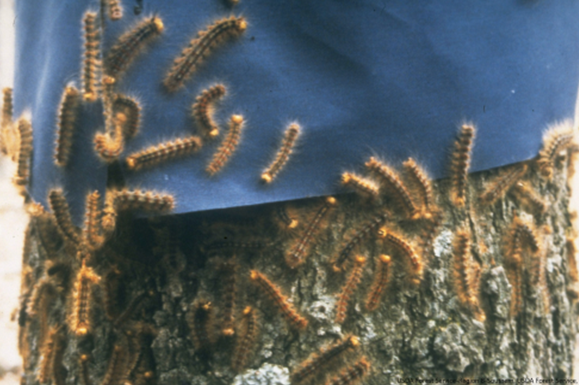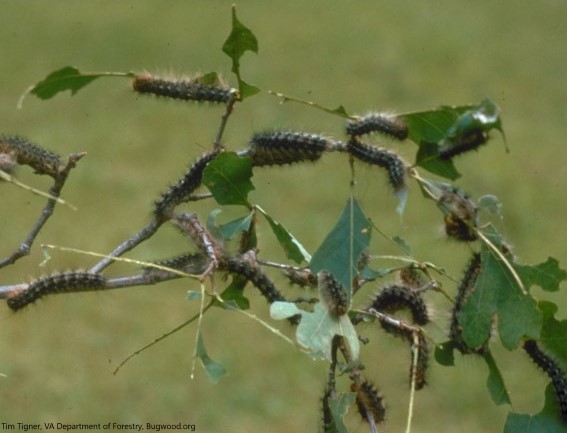Spongy moth, Lymantria dispar dispar, is an exotic pest that was introduced into the U.S. in the late 1800s. Spongy moth has been established in Vermont for a century, and populations have a temporary, large increase (“outbreak”) in an area every 6-10 years. The impacts of the caterpillar growth stage include defoliation of the forest canopy, causing stress on trees, and being a nuisance. Although consecutive years of defoliation may stress and weaken a tree, most trees will survive and will produce a second flush of leaves after the spongy moth caterpillars have stopped feeding, in late June-early July. Precipitation during the caterpillar phase can also promote natural predators and a subsequent reduction in the population.
(“outbreak”) in an area every 6-10 years. The impacts of the caterpillar growth stage include defoliation of the forest canopy, causing stress on trees, and being a nuisance. Although consecutive years of defoliation may stress and weaken a tree, most trees will survive and will produce a second flush of leaves after the spongy moth caterpillars have stopped feeding, in late June-early July. Precipitation during the caterpillar phase can also promote natural predators and a subsequent reduction in the population.
Vermont has both native (e.g., forest tent caterpillar) and invasive (e.g., spongy moth) insects that experience periodic outbreaks in our forests, and in each case our forests are resilient and tend to fare well once the outbreak has subsided. Outbreaks of defoliators in the state are cyclical, and are part of the Vermont ecosystem.
The fungus Entomophaga maimaiga is present in Vermont and the region, has the ability to control spongy moth populations and prevent outbreaks. This fungus is not always successful in managing spongy moth outbreaks, especially if a region experiences drought conditions.
Common Questions
Is there an established population in Vermont?
Yes. Spongy moth has been in Vermont for a century. The population has successfully been suppressed by an introduced fungus since 1991.
Are they under a federal quarantine?
Yes. Spongy moth is under federal quarantine, which was implemented to prevent or slow further spread of the pest. The United States Department of Agriculture defines the bounds of the spongy moth federal quarantine at the county level and is based upon the presence or absence of spongy moth, as reported by each state. To help prevent the spread of this destructive pest, the U.S. Department of Agriculture requires homeowners to inspect and remove gypsy moth egg masses from household goods prior to moving from an infested to a non-infested area. See https://www.ecfr.gov/current/title-7/subtitle-B/chapter-III/part-301/subpart-E.
If you are moving from a location within the spongy moth quarantine area, which includes the entire state of Vermont, to a location outside the quarantine area, you must inspect your outdoor household items for the gypsy moth and remove all life stages of this destructive insect before you move, https://www.upack.com/articles/how-to-check-for-spongy-moths-before-you-move
What agricultural problems do they cause?
Spongy moth can be inconspicuous in low numbers, but a population increase, which can be detected by visual inspection of trees for egg masses in the winter, will result in large and hungry caterpillars in May and June. The caterpillar will consume emerging spring vegetation in the vicinity of where they hatch. Most trees and shrubs can recover from severe defoliation, but it is a stressor and can adversely affect plant growth and health.
Is there an external quarantine?
No, spongy moth is established in Vermont.
What the Agency is doing?
Spongy moth outbreaks are difficult to control over wide areas. VAAFM does not perform any treatment or management of spongy moth. Property owners may contact a certified pesticide applicator concerning treatment options on their property. Landowners would be responsible for coordinating and covering those treatment costs. VAAFM does enforce compliance agreements on certain industries to facilitate the interstate movement of inspected commodities, such as Christmas trees.
Additional resources
- Spongy Moth | Vermont Invasives (vtinvasives.org)
- Distribution map, USDA APHIS | Federal European Gypsy Moth Quarantine
- Vermont Forest Health Update, VT FPR_LDD Leaflet_Dec 2021_final.pdf (vermont.gov)
- Exporting Christmas Trees, https://agriculture.vermont.gov/public-health-agricultural-resource-management-division/plant-health-and-pest-management/plant-4
- Exporting plants from Vermont, https://agriculture.vermont.gov/public-health-agricultural-resource-management-division/plant-health-and-est-management/plant-3

